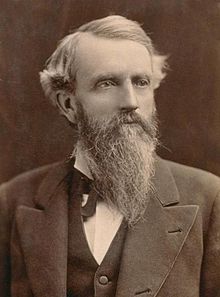
Miner
George Hearst
1820 — 1891
George Hearst, of Scots-Irish origin, was born near present-day Sullivan, Missouri, to William G. Hearst and Elizabeth Collins. Hearst was raised in a log cabin on his family's farm in rural Franklin County. His father operated three small farms, all of which were mortgaged, with slave labor. William Hearst sold his products in his own local general store. George Hearst grew up before public education was widely accessible in Missouri, so his elementary education was inconsistent and fragmented. Hearst supplemented the gaps in his formal education by observing the local mines, and reading information about minerals and mining in his free time.
When his father died in 1846, Hearst took over the care of his mother, brother and sister. In addition, he did some mining and ran a general store. He first heard of the discovery of gold in California in 1849. Before deciding to depart, he continued to read further news on the subject so that he could be more certain it was true. Finally, in 1850, as a member of a party of 16, he left for California. After arriving in 1850, he and his companions first tried placer mining in the vicinity of Sutter's Mill on the American River. After spending a cold winter and making meager findings, they moved to Grass Valley on the news of a new lode. Using his mining education and experience in Missouri, Hearst switched to prospecting and dealing in quartz mines. After almost ten years, Hearst was making a decent living as a prospector, and otherwise engaged in running a general store, mining, raising livestock and farming in Nevada County.
In the summer of 1859, Hearst learned of the silver assays of the "blue stuff" someone had picked up over what was to become the Comstock Lode, and sent to a Nevada County assayer. Hearst hurried over to the Washoe district of western Utah territory, where he arranged to buy a one-sixth interest in the Ophir Mine there, near present-day Virginia City. That winter, Hearst and his partners managed to mine 38 tons of high-grade silver ore, packed it across the Sierra on muleback, had it smelted in San Francisco, and made $91,000 profit (or roughly $2,563,528 in 2017 dollars). It was the sight of the bars of Ophir silver that started the rush to Washoe. G. Hearst knew Marcus Daly from the Comstock Lode work and in the summer of 1872 Daly suggested the possibilities of the Ontario silver mine in Park City, Utah. The Ontario carried Hearst through the Panic of 1873 and produced seventeen million dollars in ten years. Hearst later financed Marcus Daly to operate his Anaconda mine in Butte, Montana and acquired an interest in that mine as well
Last Updated on: 2024-02-28
